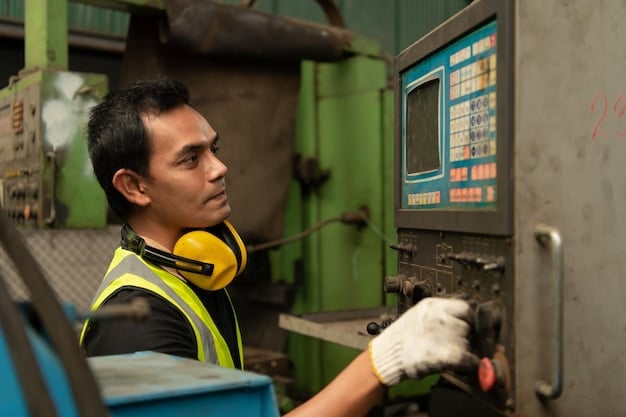The Future of US Manufacturing: Reshoring Against Supply Chain Issues

The future of US manufacturing hinges on reshoring initiatives effectively counteracting disruptions caused by global supply chain vulnerabilities, aiming to bring production and jobs back to American soil.
The landscape of American manufacturing is at a pivotal juncture. Can the future of US manufacturing: can reshoring initiatives counteract global supply chain disruptions? The question is increasingly relevant as businesses grapple with the fallout from global events and the desire for greater economic stability.
The Imperative of Reshoring for US Manufacturing
Reshoring, or bringing manufacturing back to the United States, has gained considerable traction in recent years. This movement is not just a nostalgic nod to the past; it’s a strategic response to evolving economic realities and vulnerabilities exposed by global events.
The benefits of reshoring extend beyond simple cost comparisons. It offers greater control over supply chains, reduces reliance on foreign providers, and can lead to enhanced product quality and faster innovation cycles.
The Rise of Supply Chain Vulnerabilities
Global supply chains, once lauded for their efficiency, have proven to be fragile in the face of unexpected disruptions. Events like the COVID-19 pandemic, geopolitical tensions, and natural disasters have exposed the inherent risks of relying on complex, geographically dispersed production networks.
The Allure of Domestic Production
Producing goods domestically reduces the risk of these disruptions. Localized production can lead to quicker response times, better inventory control, and greater agility in meeting changing market demands. This is particularly important in industries where speed and customization are key competitive advantages.

- Reduced transportation costs and lead times.
- Improved quality control and intellectual property protection.
- Creation of American jobs and economic stimulation.
Ultimately, the decision to reshore is a complex one that requires careful consideration of costs, benefits, and strategic objectives. However, the growing awareness of supply chain vulnerabilities has made reshoring an increasingly attractive option for US manufacturers.
Understanding the Economic Drivers of Reshoring
Several economic factors are driving the reshoring trend in the United States. These include shifting cost structures, government incentives, and a growing recognition of the long-term value of domestic production.
While labor costs in the US may be higher than in some other countries, factors like automation, improved productivity, and reduced transportation expenses can offset these differences.
The Shifting Cost Landscape
Rising wages in developing countries, coupled with increased transportation costs, have narrowed the gap between domestic and offshore production costs. In some cases, reshoring can actually be more cost-effective, especially when considering the hidden costs of managing complex global supply chains.
Government Incentives and Support
Federal and state governments have implemented various policies to encourage reshoring, including tax incentives, grants, and workforce development programs. These incentives can significantly reduce the financial burden of relocating production to the United States.
Moreover, government support for infrastructure development and technological innovation further enhances the attractiveness of the US as a manufacturing destination.

- Tax credits for investments in new equipment and facilities.
- Grants for workforce training and development.
- Simplified regulatory processes and permitting.
By carefully analyzing the economic drivers of reshoring and taking advantage of available incentives, US manufacturers can make informed decisions that support their long-term growth and competitiveness.
Technological Advancements Fueling US Manufacturing Renaissance
The resurgence of US manufacturing is intrinsically linked to technological advancements. Automation, robotics, and advanced manufacturing techniques are transforming the way goods are produced, enabling companies to be more efficient, productive, and competitive.
These technologies not only reduce labor costs but also improve quality, enhance customization capabilities, and accelerate innovation.
The Power of Automation and Robotics
Automation and robotics are at the forefront of the manufacturing revolution. Robots can perform repetitive tasks with greater precision and speed than human workers, increasing throughput and reducing errors. Automated systems can also operate 24/7, maximizing production capacity.
The Promise of Additive Manufacturing (3D Printing)
Additive manufacturing, or 3D printing, is another game-changing technology that is transforming manufacturing. 3D printing allows companies to create complex designs and prototypes quickly and cost-effectively. It also enables the production of customized products tailored to individual customer needs.
Moreover, 3D printing can reduce waste and improve material utilization, making manufacturing more sustainable and environmentally friendly.
- Improved productivity and efficiency.
- Enhanced product quality and consistency.
- Greater customization capabilities.
By embracing these technological advancements, US manufacturers can not only compete with low-cost producers in other countries but also establish themselves as leaders in innovation and high-value manufacturing.
Navigating the Challenges of Reshoring
While reshoring offers numerous benefits, it also presents certain challenges that companies must address to ensure a successful transition. These challenges include workforce development, infrastructure limitations, and regulatory compliance.
Overcoming these challenges requires a proactive approach and a commitment to investing in the resources and capabilities needed to support domestic production.
Addressing the Skills Gap
One of the biggest challenges facing US manufacturers is the skills gap. Many manufacturing jobs require specialized skills that are not readily available in the existing workforce. This gap can be addressed through targeted training programs, apprenticeship programs, and partnerships with educational institutions.
Investing in Infrastructure
Adequate infrastructure is essential for supporting a thriving manufacturing sector. This includes modern transportation networks, reliable energy supplies, and high-speed internet access. Government and private sector investments in infrastructure are critical for creating a favorable environment for reshoring.
- Developing targeted training programs to upskill the workforce.
- Investing in modern equipment and facilities.
- Streamlining regulatory processes and permitting.
By proactively addressing these challenges and investing in the resources needed to support domestic production, US manufacturers can overcome the obstacles to reshoring and reap the rewards of a stronger, more resilient domestic manufacturing base.
The Role of Government Policy in Supporting US Manufacturing
Government policy plays a crucial role in shaping the future of US manufacturing. Policies that promote innovation, support workforce development, and create a level playing field for domestic producers are essential for fostering a vibrant and competitive manufacturing sector.
Moreover, government policies can help to address market failures and create incentives for companies to invest in long-term growth and sustainability.
Promoting Innovation and Research
Government support for research and development is essential for driving innovation in manufacturing. This includes funding for basic research, support for technology transfer, and incentives for companies to invest in new technologies.
Ensuring Fair Trade Practices
Fair trade practices are essential for ensuring that US manufacturers can compete on a level playing field with foreign producers. This includes enforcing trade agreements, combating unfair trade practices, and addressing currency manipulation.
- Targeted tax incentives for domestic production.
- Investments in infrastructure and workforce development.
- Strong enforcement of trade agreements and intellectual property rights.
By enacting policies that support innovation, workforce development, and fair trade practices, the government can create an environment that fosters a thriving and competitive US manufacturing sector.
Case Studies: Successful Reshoring Initiatives
Examining successful reshoring initiatives provides valuable insights into the strategies and best practices that can lead to positive outcomes. These case studies demonstrate that reshoring can be a viable and profitable option for US manufacturers across a range of industries.
These inspiring stories highlight the potential for reshoring to create jobs, boost economic growth, and strengthen the resilience of the US economy.
Company A: A Reshoring Success Story in the Electronics Industry
Company A, a leading manufacturer of electronic components, decided to reshore its production from China to the United States. The company cited concerns about intellectual property protection, rising labor costs, and long lead times as key factors in its decision.
Company B: Bringing Apparel Manufacturing Back to the USA
Company B, a well-known apparel brand, made a commitment to reshore its production of clothing to the United States. The company cited a desire to improve quality control, reduce transportation costs, and support American jobs as motivations for its decision.
Now, Company B produces a significant portion of its clothing in the United States, creating hundreds of jobs and contributing to the revitalization of the domestic apparel industry.
- Strategic Investments in Automation and Technology.
- Strong Partnerships with Local Suppliers and Workforce Development Programs.
- A Commitment to Quality and Innovation.
These case studies provide compelling evidence that reshoring can be a successful strategy for US manufacturers. By carefully analyzing their own unique circumstances and adopting best practices, companies can increase their chances of realizing the benefits of domestic production.
| Key Point | Brief Description |
|---|---|
| 🏭 Reshoring Benefits | Brings jobs, boosts local economies, strengthens supply chains in the US. |
| 🤖 Tech Adoption | Automation & 3D printing enhance efficiency & customization in manufacturing. |
| 💰 Economic Drivers | Shifting costs & incentives make US manufacturing more competitive. |
| 🛡️ Policy Impact | Government support boosts innovation & ensures fair trade for US firms. |
Frequently Asked Questions
▼
Reshoring is the practice of bringing manufacturing and production back to the United States from overseas. It’s crucial for strengthening the US economy, creating jobs, and reducing reliance on vulnerable global supply chains.
▼
Reshoring offers benefits like reduced transportation costs, quicker lead times, better quality control, and stronger intellectual property protection, making US manufacturing more competitive and reliable.
▼
Automation, robotics, and 3D printing enhance manufacturing efficiency and reduce labor costs, making reshoring more economically feasible for US companies seeking domestic production.
▼
Reshoring challenges include skills gaps in the US workforce, infrastructure limitations, and navigating complex regulatory environments, requiring strategic investments and proactive planning for success.
▼
Government policies like tax incentives, workforce development programs, and fair trade practices are vital for encouraging reshoring, fostering a vibrant and competitive US manufacturing sector aligned with national interests.
Conclusion
The resurgence of US manufacturing through reshoring initiatives represents a strategic imperative for bolstering economic resilience and securing a more stable future. By addressing the challenges and leveraging the opportunities presented by technological innovations and supportive government policies, the United States can reclaim its position as a global manufacturing powerhouse, creating lasting benefits for businesses, workers, and communities across the nation.





